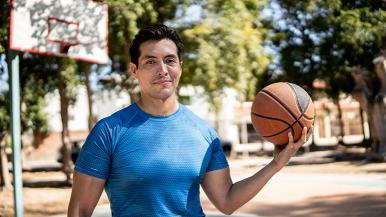Everyone knows exercise is important — and necessary — for your body, mind and spirit.
But if you're a weekend warrior with a competitive streak, you might push yourself too far, too fast and end up sidelined by a sports injury — ranging from a sprained ankle to a torn meniscus.
Over time, life changes. An athlete who had a successful college career might now have an office job, house and kids, limiting time for sports.
"The problems come when you were active, stop for awhile, then restart really fast and really hard," says Adam Yanke, MD, PhD, a sports medicine orthopedic surgeon at Rush University Medical Center.
You can avoid many weekend warrior issues by sensibly rebuilding your overall fitness. That includes focusing on flexibility, strength and aerobic conditioning. To help you get safely back in the game, Yanke offers these tips:
1. Watch what you eat and drink.
Eat a balanced diet full of fruits and vegetables and stay within a normal body mass index (BMI).
"Weight is a big factor in injuries," Yanke says. "The less weight you carry around, the less stress the knees and other joints have."
Also, stay hydrated. Drink a quart of water a day — and no, beer and coffee don't count.
2. Move throughout the day and the week.
"The key to almost any type of workout or sport is to work on the activities that support the sport, such as conditioning, stretching and strengthening," Yanke says.
First, get in 10,000 steps each day to become heart healthy and burn enough calories. Try a stand-up desk — or take breaks throughout the day to stand up and walk around — find ways to engage your core muscles and develop better posture.
Over time, add sports-specific workouts, gradually increasing time and intensity to build toward three 45-minute workouts each week. "That's enough physical activity to be healthy and keep your body fit," Yanke says. "Plus, it's a manageable amount of time for most people, and lets them feel successful."
And scheduling those workouts every other day allows for all-important rest and recovery time, so you won't burn out.
3. Warm up and cool down.
It's impossible to over-emphasize how crucial stretching is to preventing long-term overuse issues. Yet often we blow it off. "People tend to dive straight into the activity because that's the fun part," Yanke says.
But not warming up can have consequences: Tight tendons and muscles are more likely to be strained and snapped. To protect yourself, do a 15-20 minute dynamic workout before you start your activity. That means stretching combined with movement, like walking lunges or jumping jacks.
Don't forget to leave time to stretch after your workout, too, Yanke advises. But post-workout, opt for static stretches, and hold each stretch for 30 seconds. "Not only does this help your muscles relax, but it provides time for your heart rate to recover."
The key to almost any type of workout or sport is to work on the activities that support the sport, such as conditioning, stretching and strengthening
4. Condition yourself for your sport.
Research websites for ideas on how to train for your sport — including learning which joints and muscles need extra conditioning.
For example, basketball players should do squats and single-leg lunges to build quadriceps and hamstrings and protect knees. Tennis players can develop important shoulder and core muscles by doing planks.
Find other ideas by joining a club and trading notes with other members about how they train and condition themselves.
If possible, hire a personal trainer or coach who can help you learn the correct form. Using proper form when playing a sport can help prevent non-contact injuries, such as ACL tears, so it pays to learn from a pro.
5. Mix it up.
"If you do one sport too much, you can overwork those muscles and joints, so cross training is important," Yanke says. "Test your body in different ways by working different muscles and giving other muscle groups a break."
For instance, if you are an avid runner, try swimming laps instead twice a month for variety.
6. Set realistic goals and listen to your body.
You may mentally be ready to run a 10K after the holidays. But if you don't train correctly and work gradually up to that distance, you'll increase your risk of overuse injuries, like stress fractures and muscle strains.
If your workout is causing pain, back off. "That doesn't mean you have to give up the sport altogether, but you do need to respect that your body may need a break," Yanke says.
In other words, don't ignore the signals your body is sending. If running a 20-mile race is painful, make 10 miles your goal and add a second activity — like biking or swimming — as a substitute for the miles you're missing.
7. Know — and accept — your limits.
Remember that as you age, your body's ability to recover and repair slows down, and your physical reserves deplete.
That doesn't mean you should stop being active — in fact, the opposite is true; lifelong physical activity is essential keep your entire body healthy and strong — but you may need to dial it down a notch.
For instance, if you can't dart around the tennis court like you used to, find a partner and start playing doubles instead of singles. You'll still get to enjoy the sport, but with less stress to your body.
Don't let your ego get in the way. "That desire to play at a competitive level can get you in trouble," Yanke says. "I won't say you can't do what you used to do, but it may take more effort to maintain the same level of fitness you are used to. And it's better to play it safe than to risk getting hurt."
8. Tend to injuries.
Even the best conditioning plan can't prevent every injury. But if you tend to minor issues — including muscle aches, stiffness and mild sprains — you can help prevent more serious problems down the road. Yanke offers these post-workout tips:
- Use R.I.C.E. Rest your body, ice down what's hurting, wrap and compress the area, and keep the injury slightly elevated. "Rest is the most important step," Yanke says. "Take it easy for a few days, or transition temporarily to a workout that doesn't aggravate the current condition."
- Take an anti-inflammatory medication. Use nonsteroidal anti-inflammatories such as ibuprofen or naproxen for swelling and inflammation. "Many of my patients say they try to avoid overusing medications," Yanke says. "But in this case, you'll only be taking them for a short period of time to break the cycle of inflammation and pain."
- See a doctor. If you have severe bruising, pain or swelling that comes on suddenly or doesn't respond to over-the-counter medicine and home care after two or three days, go to your primary care doctor or a primary care sports medicine physician. Then, follow through on the doctor's advice.
Most important: "Take the time to take care of yourself," Yanke says. "You do routine maintenance on your car. Your body also needs attention to keep everything running smoothly."





